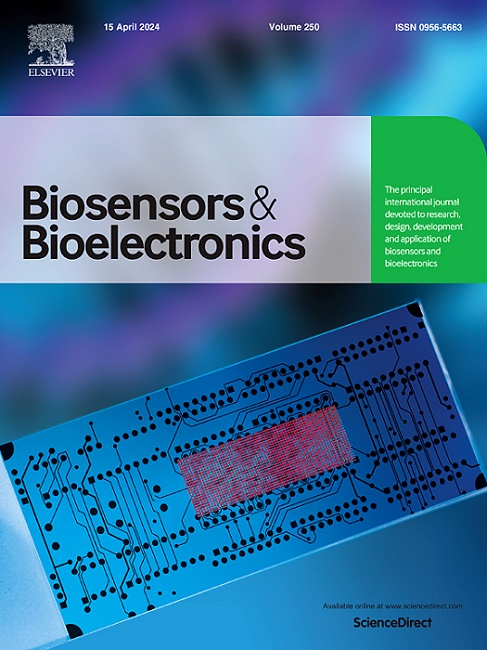Rapid and sensitive biosensing of uropathogenic E. coli using plasmonic nanohole arrays on MIM: Bridging the gap between lab and clinical diagnostics
IF 10.7
1区 生物学
Q1 BIOPHYSICS
引用次数: 0
Abstract
This study introduces a novel biosensing platform, Plasmonic Array Nanohole Technology on Metal-Insulator-Metal (PANTOMIM), designed to overcome limitations of traditional plasmonic nanohole array biosensors. PANTOMIM utilizes a metal-insulator-metal structure as a lossy waveguide to dampen metal/substrate peaks, ensuring high extinction coefficients and spectral purity for biosensing. The architecture is optimized for the 800–850 nm wavelength range, with potential for future integration into nanophotonic devices. To demonstrate its clinical utility, we applied PANTOMIM to the detection of uropathogenic Escherichia coli (UPEC) in urine samples. This approach addresses the need for rapid diagnosis of urinary tract infections, providing results in 15 min and requiring minimal sample preparation. The efficacy of the technology was validated in a clinical setting with a cohort of 100 patients, showcasing its potential to revolutionize the detection of UPEC. PANTOMIM combines the advantages of plasmonic nanohole arrays, including tunable periodicity, coupled plasmonic response, and extraordinary optical transmission, while mitigating the challenges associated with thin-film plasmonic metals. This innovation paves the way for integrated nanoplasmonic biosensors for point-of-care diagnostics.
求助全文
约1分钟内获得全文
求助全文
来源期刊

Biosensors and Bioelectronics
工程技术-电化学
CiteScore
20.80
自引率
7.10%
发文量
1006
审稿时长
29 days
期刊介绍:
Biosensors & Bioelectronics, along with its open access companion journal Biosensors & Bioelectronics: X, is the leading international publication in the field of biosensors and bioelectronics. It covers research, design, development, and application of biosensors, which are analytical devices incorporating biological materials with physicochemical transducers. These devices, including sensors, DNA chips, electronic noses, and lab-on-a-chip, produce digital signals proportional to specific analytes. Examples include immunosensors and enzyme-based biosensors, applied in various fields such as medicine, environmental monitoring, and food industry. The journal also focuses on molecular and supramolecular structures for enhancing device performance.
 求助内容:
求助内容: 应助结果提醒方式:
应助结果提醒方式:


